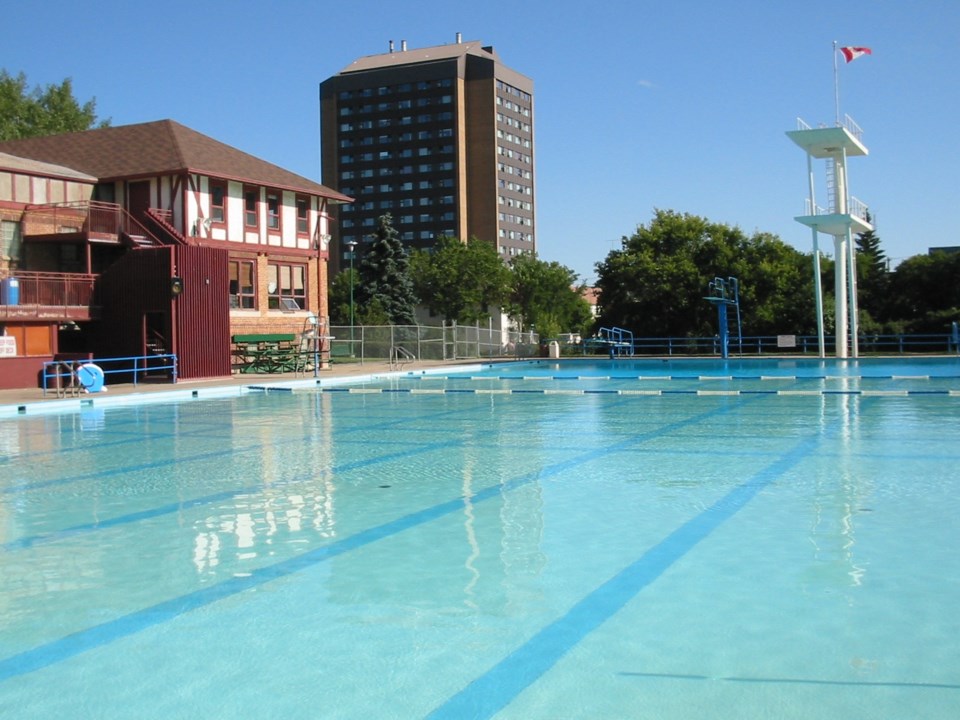The parks and recreation department plans to pursue a $6-million federal grant to help replace the Phyllis Dewar Outdoor Pool, a project whose cost has ballooned to over $10 million.
During its Feb. 27 regular meeting, city council voted unanimously to authorize the department to submit a funding application to the federal Green and Community Buildings Program (GCBP) for a new outdoor aquatic park.
The proposed venue would replace the existing eight-lane, 50-metre pool with a new changeroom building with a reception desk, gender-neutral changerooms, concession, staff rooms, pool mechanical space and storage rooms.
There would also be a new eight-lane, 25-metre lap pool with accessible ramped entry, a separate leisure pool with accessible entry, a lazy river, tot pool, interactive spray features, and 40-metre water slide.
The preliminary budget suggests the aquatic centre will cost $10,097,933, excluding GST. City hall expects the federal grant to provide $5,730,653, the Rural Municipality of Moose Jaw to contribute $50,000 and the city to kick in $4,317,280.
The City of Moose Jaw will use six funding sources for its contribution:
- $152,163 from this year’s parks and rec capital budget
- $1,989,150 from next year’s parks and rec capital budget
- $2,205,967 from the 2025 parks and rec capital budget
- $10,000 from the RM in 2026, 2027 and 2028
This is city hall’s second attempt at procuring federal funding for this project after learning in July that its application to another initiative was unsuccessful because the number of applications exceeded the available funding.
The parks and rec department estimated last August that the project could cost $8,999,434. It then budgeted $8,700,800 for the initiative in its five-year capital funding plan. This means the project has increased by $1,397,133 since council approved that plan in December.
This extra money is not budgeted and is something the city would have to find if this application is successful.
The federal government will cover 60 per cent of costs while the municipality is responsible for 40 per cent, director Derek Blais said during the meeting. However, the city only budgeted for 33 per cent of eligible costs based on the previous application.
One reason the cost has increased is that the Green and Community Buildings Program recommends having an 18-per-cent contingency for class C estimates, whereas the project’s previous budget had a 10-per-cent contingency, he continued.
Therefore, the additional eight per cent adds $720,000 to costs.
There is also money within that to relocate a storm line that runs below the proposed new changeroom. The city could also explore using geothermal to power the building.
“We feel the contingency will help us support the new design to be net-zero (in carbon dioxide production). There might be some additional costs associated with that, so we feel the 18 per cent might help,” Blais said.
An “integral component” of the GCBP is that the municipality must design and build the new venue to be net-zero. That means the building must be highly energy efficient, producing — or procuring — on-site carbon-free renewable energy or sufficient high-quality carbon offsets to address the annual emissions from building materials and operations.
If the application is successful, the pool season would open next year around May and close in early August, Blais said. Construction would begin that fall until freeze-up and then re-start in June 2025. The pool season would then open the July long weekend until late August.
Projections in the new pool’s annual operating budget suggest revenues could increase by $61,000 and expenses decrease by $123,000, leading to annual net savings of $184,000, he added. A big part of the reductions would be $47,750 in utility savings from having a net-zero building.
The next regular council meeting is Monday, March 13.




